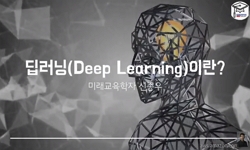A mobile system with limited computing and storage capacity mainly processes the training and inference of deep learning in a data center. Therefore, it is difficult for a mobile system to provide private artificial intelligence services, and users ma...
http://chineseinput.net/에서 pinyin(병음)방식으로 중국어를 변환할 수 있습니다.
변환된 중국어를 복사하여 사용하시면 됩니다.
- 中文 을 입력하시려면 zhongwen을 입력하시고 space를누르시면됩니다.
- 北京 을 입력하시려면 beijing을 입력하시고 space를 누르시면 됩니다.
https://www.riss.kr/link?id=A105619758
- 저자
- 발행기관
- 학술지명
- 권호사항
-
발행연도
2018
-
작성언어
Korean
- 주제어
-
KDC
004
-
등재정보
KCI등재
-
자료형태
학술저널
- 발행기관 URL
-
수록면
1-9(9쪽)
-
KCI 피인용횟수
0
- DOI식별코드
- 제공처
-
0
상세조회 -
0
다운로드
부가정보
다국어 초록 (Multilingual Abstract)
A mobile system with limited computing and storage capacity mainly processes the training and inference of deep learning in a data center. Therefore, it is difficult for a mobile system to provide private artificial intelligence services, and users may be reluctant to transfer personal information to data centers. Therefore, this paper proposes a deep learning acceleration algorithm for convolutional neural network where a mobile system enables learning and inference itself. The proposed algorithm efficiently reduces the size of the convolutional neural network by a low-rank approximation method that compacts the information of the neural network into some weights, and a pruning method that removes non-critical weights. Experimental results show that the proposed algorithm achieves the speed of inference 1.65 times faster, requires the number of fine-tune fewer 1.5 times, and reduces the memory capacity for storing weights 2 times less than the conventional prunning algorithm.
참고문헌 (Reference)
1 공기호, "피부색과 S-LGP와 U-LGP기반 CNN을 이용한 얼굴 검출 알고리즘 연구" 한국정보기술학회 15 (15): 107-113, 2017
2 M. Rhu, "vDNN: Virtualized deep neural networks for scalable, memory-efficient neural network design" 1-13, 2016
3 K. Simonyan, "Very deep convolutional networks for large-scale image recognition" 1-14, 2015
4 D. Jeong, "Trend on Artificial Intelligence Technology and Its Related Industry" 15 (15): 21-28, 2017
5 S. Anwar, "Structured pruning of deep convolutional neural networks" 13 (13): 12-, 2017
6 G. Chen, "Smallfootprint keyword spotting using deep neural networks" 4087-4091, 2014
7 K. Baker, "Singular value decomposition tutorial" 24-, 2005
8 J. Chung, "Simplifying deep neural networks for neuromorphic architectures" 1-6, 2016
9 A. Parashar, "Scnn: An accelerator for compressed-sparse convolutional neural networks" 27-40, 2017
10 J. Yu, "Scalpel: Customizing dnn pruning to the underlying hardware parallelism" 548-560, 2017
1 공기호, "피부색과 S-LGP와 U-LGP기반 CNN을 이용한 얼굴 검출 알고리즘 연구" 한국정보기술학회 15 (15): 107-113, 2017
2 M. Rhu, "vDNN: Virtualized deep neural networks for scalable, memory-efficient neural network design" 1-13, 2016
3 K. Simonyan, "Very deep convolutional networks for large-scale image recognition" 1-14, 2015
4 D. Jeong, "Trend on Artificial Intelligence Technology and Its Related Industry" 15 (15): 21-28, 2017
5 S. Anwar, "Structured pruning of deep convolutional neural networks" 13 (13): 12-, 2017
6 G. Chen, "Smallfootprint keyword spotting using deep neural networks" 4087-4091, 2014
7 K. Baker, "Singular value decomposition tutorial" 24-, 2005
8 J. Chung, "Simplifying deep neural networks for neuromorphic architectures" 1-6, 2016
9 A. Parashar, "Scnn: An accelerator for compressed-sparse convolutional neural networks" 27-40, 2017
10 J. Yu, "Scalpel: Customizing dnn pruning to the underlying hardware parallelism" 548-560, 2017
11 J. Wu, "Quantized convolutional neural networks for mobile devices" 4820-4828, 2016
12 G. Poli, "Processing neocognitron of face recognition on high performance environment based on GPU with CUDA architecture" 81-88, 2008
13 S. Han, "Learning both weights and connections for efficient neural network" 1135-1143, 2015
14 A. Krizhevsky, "Imagenet classification with deep convolutional neural networks" 1097-1105, 2012
15 Y. LeCun, "Gradient-based learning applied to document recognition" 86 (86): 2278-2324, 1998
16 C. Szegedy, "Going deeper with convolutions" 1-9, 2015
17 J. Qiu, "Going Deeper with Embedded FPGA platform for Convolutional Neural Network" 26-35, 2016
18 J. Ye, "Generalized low rank approximations of matrices" 61 (61): 167-191, 2005
19 J. Park, "Faster cnns with direct sparse convolutions and guided pruning" 2016
20 R. Girshick, "Fast R-CNN" 1440-1448, 2015
21 S. Han, "Deep Compression: Compressing Deep Neural Networks with Pruning, Trained Quantization and Huffman Coding" 1-14, 2015
22 Y. D. Kim, "Compression of deep convolutional neural networks for fast and low power mobile applications" 1-16, 2015
23 Y. Jia, "Caffe: Convolutional architecture for fast feature embedding" 675-678, 2014
24 T. Roughgarden, "CS168: The Modern Algorithmic Toolbox Lecture# 9: The Singular Value Decomposition (SVD) and Low-Rank Matrix Approximations" 2-7, 2015
25 R. Collobert, "A unified architecture for natural language processing: Deep neural networks with multitask learning" 160-167, 2008
동일학술지(권/호) 다른 논문
-
- 한국정보기술학회
- 박종안(Jong-An Park)
- 2018
- KCI등재
-
- 한국정보기술학회
- 이권윤(Gwon-Yoon Lee)
- 2018
- KCI등재
-
Feature Selection of SVM-RFE Combined with a TD Reinforcement Learning
- 한국정보기술학회
- Chayoung Kim
- 2018
- KCI등재
-
DRAM의 성능 향상을 위한 Pre-Refresh 기법
- 한국정보기술학회
- 조민신(Minshin Cho)
- 2018
- KCI등재
분석정보
인용정보 인용지수 설명보기
학술지 이력
| 연월일 | 이력구분 | 이력상세 | 등재구분 |
|---|---|---|---|
| 2022 | 평가예정 | 재인증평가 신청대상 (재인증) | |
| 2019-01-01 | 평가 | 등재학술지 유지 (계속평가) |  |
| 2016-01-01 | 평가 | 등재학술지 유지 (계속평가) |  |
| 2012-01-01 | 평가 | 등재학술지 유지 (등재유지) |  |
| 2009-01-01 | 평가 | 등재학술지 선정 (등재후보2차) |  |
| 2008-01-01 | 평가 | 등재후보 1차 PASS (등재후보1차) |  |
| 2006-01-01 | 평가 | 등재후보학술지 선정 (신규평가) |  |
학술지 인용정보
| 기준연도 | WOS-KCI 통합IF(2년) | KCIF(2년) | KCIF(3년) |
|---|---|---|---|
| 2016 | 0.45 | 0.45 | 0.39 |
| KCIF(4년) | KCIF(5년) | 중심성지수(3년) | 즉시성지수 |
| 0.38 | 0.35 | 0.566 | 0.16 |




 ScienceON
ScienceON DBpia
DBpia






